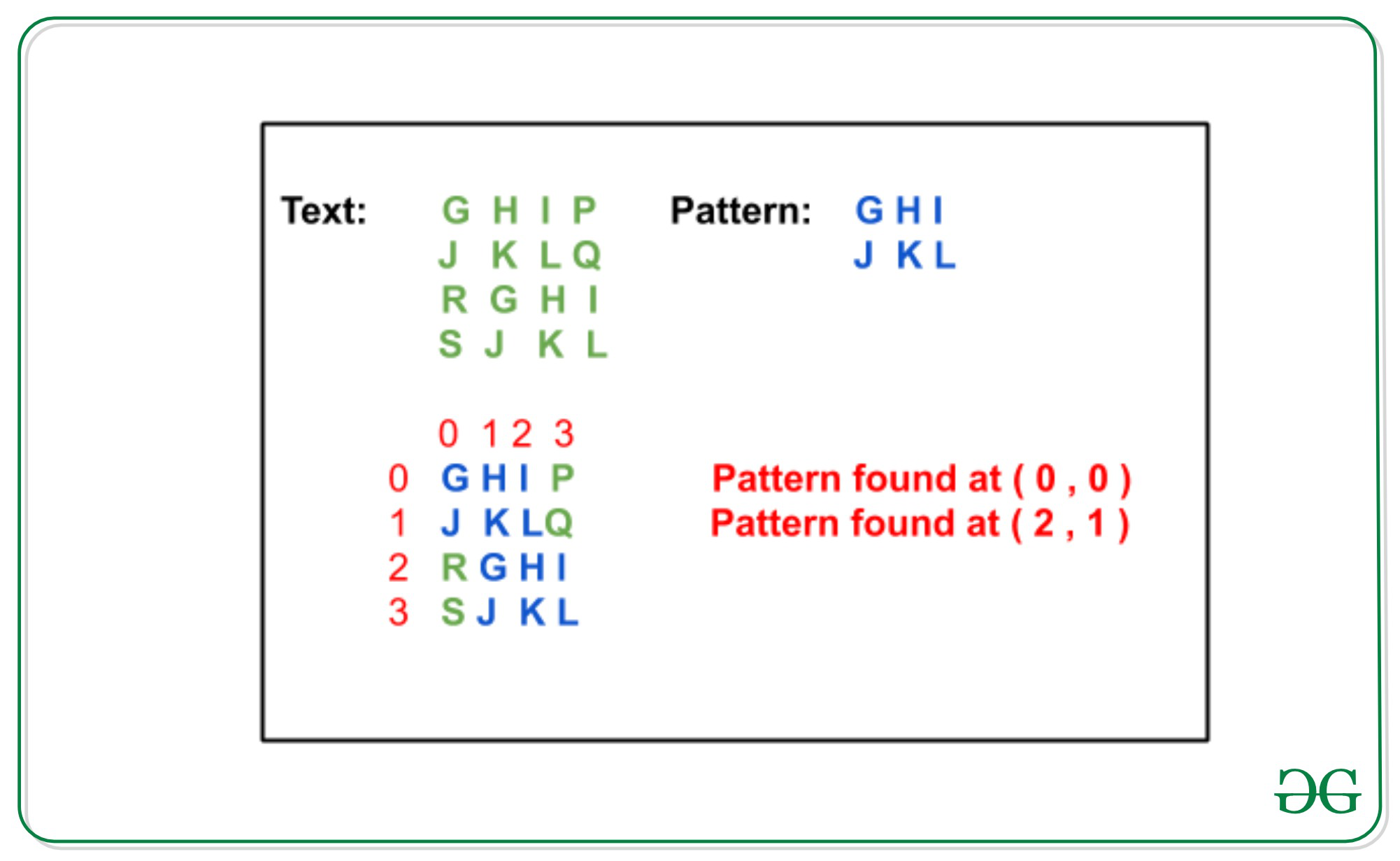给定尺寸为m1 x m2的矩阵txt [] []和尺寸为n1 x n2的模式pat [] [] ,任务是检查矩阵中是否存在某个模式,如果是,则打印od的顶部mot索引。 txt [] []中的pat [] [] 。假设m1,m2≥n1,n2
例子:
输入: txt [] [] = {{G,H,I,P} {J,K,L,Q} {R,G,H,I} {S,J,K,L}} pat [] [ ] = {{G,H,I},{J,K,L}}输出:在(0,0)找到的模式在(2,1)找到的模式说明:  输入: txt [] [] = {{A,B,C},{D,E,F},{G,H,I}} pat [] [] = {{E,F},{H,I输出:在(1,1)找到的模式
输入: txt [] [] = {{A,B,C},{D,E,F},{G,H,I}} pat [] [] = {{E,F},{H,I输出:在(1,1)找到的模式
方法:为了使用Rabin-Karp算法在二维数组中查找模式,请考虑输入矩阵txt [m1] [m2]和模式pat [n1] [n2] 。这个想法是找到mat [] []和pat [] []的每一列的哈希值,并比较哈希值。对于任何列,如果哈希值等于,则检查相应的行值。步骤如下:
- 在txt [] []和pat [] []矩阵中找到前N1行的每一列的哈希值。
- 通过为步骤1中找到的列哈希查找哈希值来应用Rabin-Karp算法。
- 如果找到匹配项,则比较特定行和列的txt [] []和pat [] []矩阵。
- 否则,使用滚动哈希将txt矩阵中的列哈希值向下滑动1行。
- 重复步骤2至4对所有的哈希值,如果我们发现任何拍拍[] []匹配在TXT [] []然后打印最上面的单元格的指数在TXT [] []。
查找哈希值:为了使用滚动哈希在文本中找到大小为N的子字符串的哈希值,请执行以下步骤:
- 从字符串删除第一个字符: hash(txt [s:s + n-1])-(radix **(n-1)* txt [s])%prime_number
- 将下一个字符添加到字符串: hash(txt [s:s + n-1])* radix + txt [n]
下面是上述方法的实现:
Python3
# Python implementation for the
# pattern matching in 2-D matrix
# Function to find the hash-value
# of the given columns of text
def findHash(arr, col, row):
hashCol = []
add = 0
radix = 256
# For each column
for i in range(0, col):
for j in reversed(range(0, row)):
add = add + (radix**(row-j-1) *
ord(arr[j][i]))% 101
hashCol.append(add % 101);
add = 0
return hashCol
# Function to check equality of the
# two strings
def checkEquality(txt, row, col, flag):
txt = [txt[i][col:patCol + col]
for i in range(row, patRow + row)]
# If pattern found
if txt == pat:
flag = 1
print("Pattern found at", \
"(", row, ", ", col, ")")
return flag
# Function to find the hash value of
# of the next column using rolling-hash
# of the Rabin-karp
def colRollingHash(txtHash, nxtRow):
radix = 256
# Find the hash of the matrix
for j in range(len(txtHash)):
txtHash[j] = (txtHash[j]*radix \
+ ord(txt[nxtRow][j]))% 101
txtHash[j] = txtHash[j] - (radix**(patRow) *
ord(txt[nxtRow-patRow][j]))% 101
txtHash[j] = txtHash[j]% 101
return txtHash
# Function to match a pattern in
# the given 2D Matrix
def search(txt, pat):
# List of the hashed value for
# the text and pattern columns
patHash = []
txtHash = []
# Hash value of the
# pat_hash and txt_hash
patVal = 0
txtVal = 0
# Radix value for the input characters
radix = 256
# Variable to determine if
# pattern was found or not
flag = 0
# Function call to find the
# hash value of columns
txtHash = findHash(txt, txtCol, patRow)
patHash = findHash(pat, patCol, patRow)
# Calculate hash value for patHash
for i in range(len(patHash)):
patVal = patVal \
+ (radix**(len(patHash)-i-1) *
patHash[i]% 101)
patVal = patVal % 101
# Applying Rabin-Karp to compare
# txtHash and patHash
for i in range(patRow-1, txtRow):
col = 0
txtVal = 0
# Find the hash value txtHash
for j in range(len(patHash)):
txtVal = txtVal\
+ (radix**(len(patHash)-j-1) *
txtHash[j])% 101
txtVal = txtVal % 101
if txtVal == patVal:
flag = checkEquality(\
txt, i + 1-patRow, col, flag)
else:
# Roll the txt window by one character
for k in range(len(patHash), len(txtHash)):
txtVal = txtVal \
* radix + (txtHash[k])% 101
txtVal = txtVal \
- (radix**(len(patHash)) *
(txtHash[k-len(patHash)]))% 101
txtVal = txtVal % 101
col = col + 1
# Check if txtVal and patVal are equal
if patVal == txtVal:
flag = checkEquality(\
txt, i + 1-patRow, col, flag)
else:
continue
# To make sure i does not exceed txtRow
if i + 1输出:
Pattern found at ( 1 , 1 )